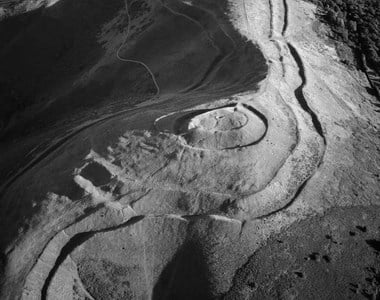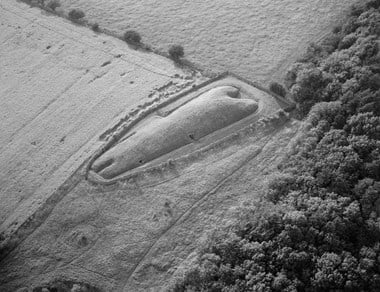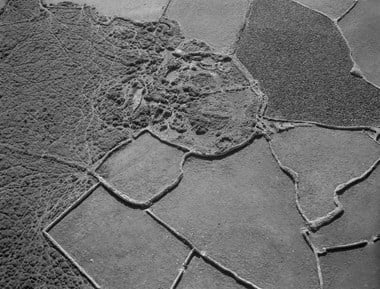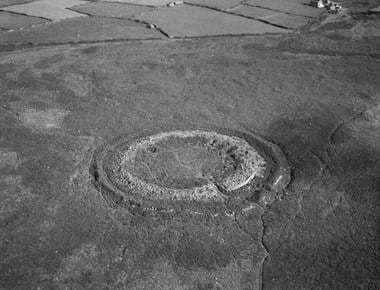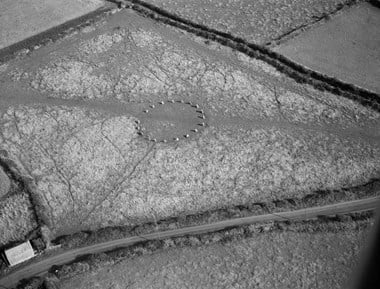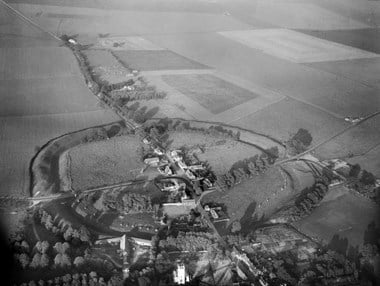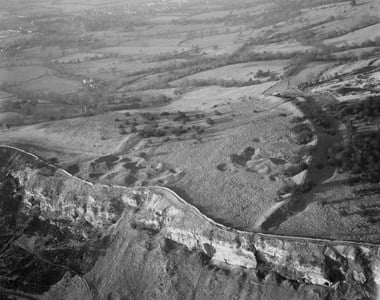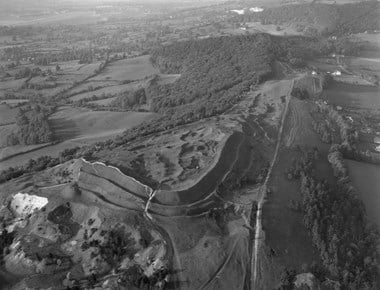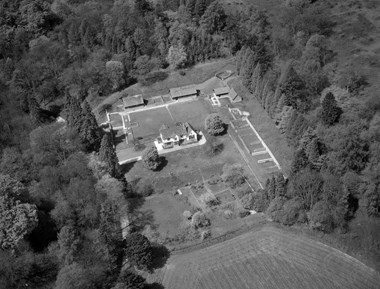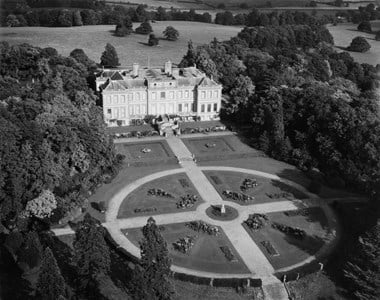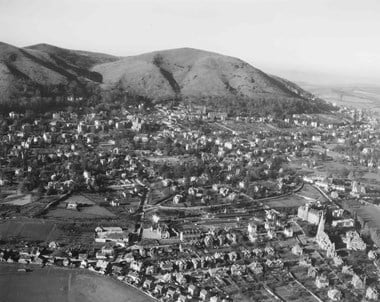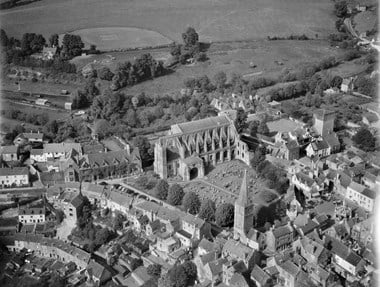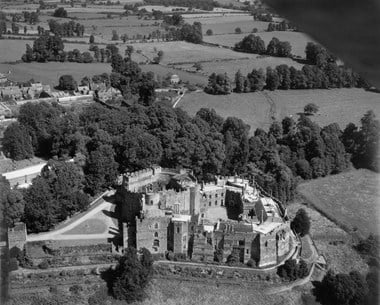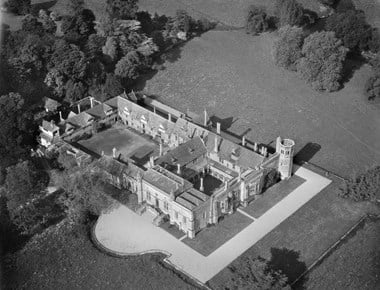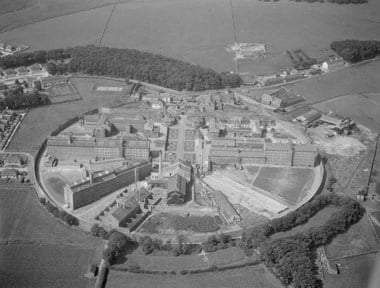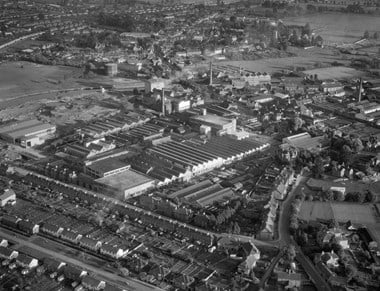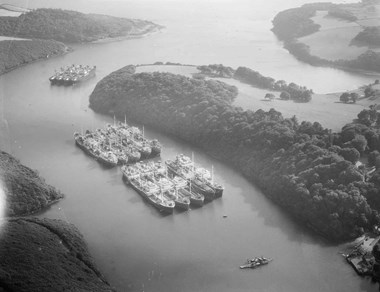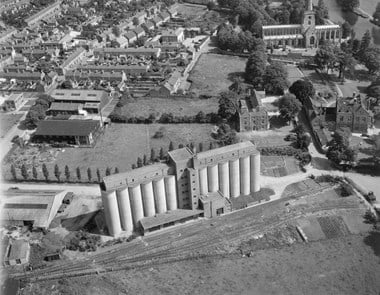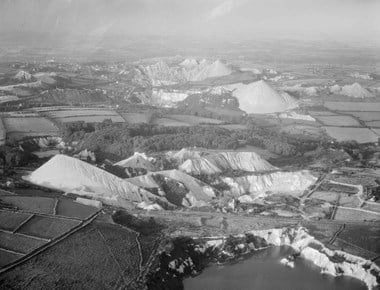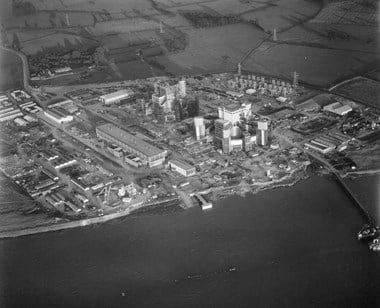Barrows to Bridges: the Harold Wingham Collection of Aerial Photographs
The quality of this photography is stunning.
The Harold Wingham Collection is one of the Historic England Archive's favourite collections of aerial photographs. It is celebrated because of the quality of the imagery and because of its mix of subjects. It includes architectural, archaeological and industrial sites, and views of villages and towns in the early post-war period.
Taken between 1951 and 1963, Harold’s photographs record the ancient and modern, from Iron Age hillforts to factory complexes, castles and cathedrals to docks and river crossings.
Who was Harold Wingham?
Harold Wingham has been described as an “unsung hero” and “pioneer” of aerial photography. It was a practice that he considered to be “an essential technique of modern archaeology”.
Harold was born at Calmore on the eastern edge of the New Forest in Hampshire on 7 April 1924. In 1942, aged 18, he joined the Royal Air Force (RAF) and qualified as a wireless operator. He also trained as a navigator but was unable to complete the course due to illness.
Harold left the RAF in 1947. The following year he worked at the Ministry of Civil Aviation at Winstone in Gloucestershire and later for the Gloster Aircraft Corporation where he worked with large format cameras. Between 1947 and 1950, Harold obtained his Radiotelegraphy (Air) licence, Aviator’s Certificate and private pilot’s licence.
It was in the late 1940s that Harold started aerial photography. Encouraged by the archaeologist Osbert Guy Stanhope Crawford, the renowned advocate for the use of aerial photography for archaeology, Harold acquired government surplus camera equipment and film. He began recording the archaeology, buildings and industries of west and south-west England.
Harold had a passion for hot air balloons and especially airships, which he promoted as a more stable and cost-effective platform for aerial photography and archaeological survey. He believed that this “new weapon in the archaeologist’s armoury” would reveal even more archaeology than had already been observed by aeroplane. In the 1960s, Harold worked on a design for a two-man airship but the project came to an unsuccessful end in the mid-1970s.
Harold’s commitment to taking photographs from the air ended in tragic circumstances. In 1963 he witnessed an air crash that killed his pilot, a close friend. Despite this, Harold’s interest in archaeology continued after he stopped flying. He became actively involved in local field archaeology, including taking part in excavations at sites in Gloucestershire. Harold was a founder member of the Gloucester and District Archaeological Research Group (GADARG), later Gloucestershire Archaeology, and contributed articles to its journal ‘Glevensis’.
It was through his associations with GADARG and the Cranham Local History Society that the Historic England Archive learned of Harold’s death, aged 97, on 12 November 2021. Harold has been described as “a shy, modest and self-effacing man” whose “air photography made a unique contribution to the archaeology of Gloucestershire and far beyond”.
How were the photographs taken?
The aerial photographer using an aeroplane has many problems, several of which have to be resolved in the last couple of seconds before releasing the shutter and when engaged in archaeological work these problems are increased.
The photographs in the Harold Wingham Collection were taken from light aeroplanes using hand-held cameras that were specifically designed for aerial photography. They were often taken from very low altitude. Harold estimated that in some instances, he had only half a second to make his exposure.
Harold recommended using a camera with a large negative size (five inch by four inch was considered ‘the most practical for most purposes’) and an eight-inch lens. Camera shake caused by strong wind, turbulence and vibration could affect the quality of photographs and so a solid, well-balanced camera with hand grips was required.
Harold used hand-held Williamson F24 and Fairchild K20 cameras. Both were designed for military aerial reconnaissance. They weighed 24 pounds and 12 pounds respectively, supporting Harold’s view that cameras should be as heavy as could be handled. Both could take magazines of roll film for scores of exposures.
Another difficulty faced by Harold was communication with his pilot. Photographs had to be taken with the aeroplane’s window open, so noise levels were high. Most photographs were taken at an angle, which meant that the aeroplane had to be turning or banking, with the pilot having little or no view of the target of the photograph.
These were just some of the challenges faced by Harold and his pilot. They help us to appreciate just how good the photographs in the Harold Wingham Collection are.
What’s in the collection?
The Harold Wingham Collection of Aerial Photographs comprises almost 2,000 photographic negatives and corresponding photographic prints. It is divided into 86 flights, which were flown between April 1951 and July 1963.
Each flight resulted in between one and over 100 photographs of one or more targets. For example, Flight UHAW1365, flown on 4 May 1958 has 28 photographs recording views of targets such as the Severn Railway Bridge, Bathurst Park, Tintern Abbey and St Briavel’s Castle.
The photographs in the collection cover sites in the historic counties of Cornwall, Devon, Gloucestershire, Hampshire, Herefordshire, Monmouthshire, Oxfordshire, Somerset, Warwickshire, Worcestershire and Wiltshire.
Harold Wingham Collection sites map
When was the collection acquired?
Harold Wingham contacted the National Buildings Record (NBR), a predecessor of the Historic England Archive, in 1957. The offer of aerial photographs of “big houses, castles and similar subjects” was met positively. A set of sample images was described as “excellent” and a request for 51 of Harold’s prints was made. Around the same time, Harold was also offering his photographs to the Paul Popper Ltd Photographic Agency.
In 1970, the Royal Commission on the Historical Monuments of England, which had merged with the NBR in 1963, renewed its interest in Harold’s photography. The Commission’s Air Photograph’s Officer, John Hampton, wrote to Harold to request more photographs to enhance its Air Photographs Library. In the 1990s, the Commission acquired further sets of negatives, including those that he had previously produced for Paul Popper, and two of Harold’s cameras.
What can I see in the photographs?
The subjects in the Harold Wingham Collection of Aerial Photography can be divided into three broad categories: archaeology, buildings and places, and industry and transport.
Archaeology
Aerial photography is an essential technique of modern archaeology, yet there is still a good deal of improvement in its practice. Light aeroplanes are used for most oblique work, particularly for relatively low-level work, but not being designed for aerial photography they are far from satisfactory.
Harold Wingham’s aerial photographs record archaeological features, prehistoric settlements and ancient monuments in the varied landscapes of west and south-west England, from barrows and hillforts to stone circles and deserted medieval villages.
Often utilising strong, low, raking light, Harold’s oblique photographs reveal the banks, ditches hollows, upright stones and low walls of hillforts and other monuments with contrasting light and shadow, which otherwise may not have been so visible in the landscape.
Gallery
Please click on the gallery images to enlarge.
Buildings and places
As well as photographing archaeological features in the landscape, Harold Wingham recorded historic, and sometimes more recent, buildings.
Favourite subjects include well-known abbeys and cathedrals, parish churches, castles and country houses. Some views show buildings in the wider context of their settings or more general shots of towns, such as the Shakespeare Memorial Theatre in Stratford-upon-Avon, or the streets of Great Malvern backed by the majestic Malvern Hills.
Gallery
Please click on the gallery images to enlarge.
Industry and transport
Harold Wingham's aerial photography includes views of buildings and infrastructure relating to industry and transport. Many of the sites Harold photographed had a long history and were closely related to local geography and resources. Several were soon to face uncertain futures.
Today, Harold’s photographs are an important record of industries that have survived, and those that have since declined, and of the engineering feats and transport infrastructure that have since been demolished.
Gallery
Please click on the gallery images to enlarge.
Acknowledgements
The Historic England Archive would like to thank Richard Savage, Lydia Savage, Michael Hare, Ray Wilson and Phillip Cox for generously sharing their knowledge and memories of the late Harold Wingham and his work.
Sources
Cox, P, 2022 ‘Obituary: Harold Wingham (1924-2021)’ in Glevensis: Gloucestershire Archaeology Annual Review, No 54: 2021, 2-3
Hall, G, 1997 ‘Harold Wingham: pioneer aerial photographer’ in AARGnews 15 (September 1997), 9-11
Luffman, C, 2013 ‘The Gloster Story: A Tale of Two Airships That Were One’ in Dirigible: The Journal of the Airship Heritage Trust, No. 70 (Autumn 2013), 18-21
Wingham, H, 1970 ‘Airships and Archaeology’ in GLEVENSIS The Gloucester and District Archaeological Research Group Review, No. 5, 2-7
-
Aerial Photo Explorer
View aerial photographs including those from the Harold Wingham Collection via an interactive map.
-
Celebrating the Harold Wingham Collection Through Active Participation
Read about a collaborative project to remember the work of Harold Wingham in our Historic England Research article.
-
Browse the Collection
Discover more about the content of the Harold Wingham Collection of Aerial Photographs.
-
Prints and Gifts
A selection of Harold Wingham’s photographs can be purchased as prints and gifts.
Three online galleries co-created with former associates of Harold Wingham can be viewed on the Google Arts & Culture website:


